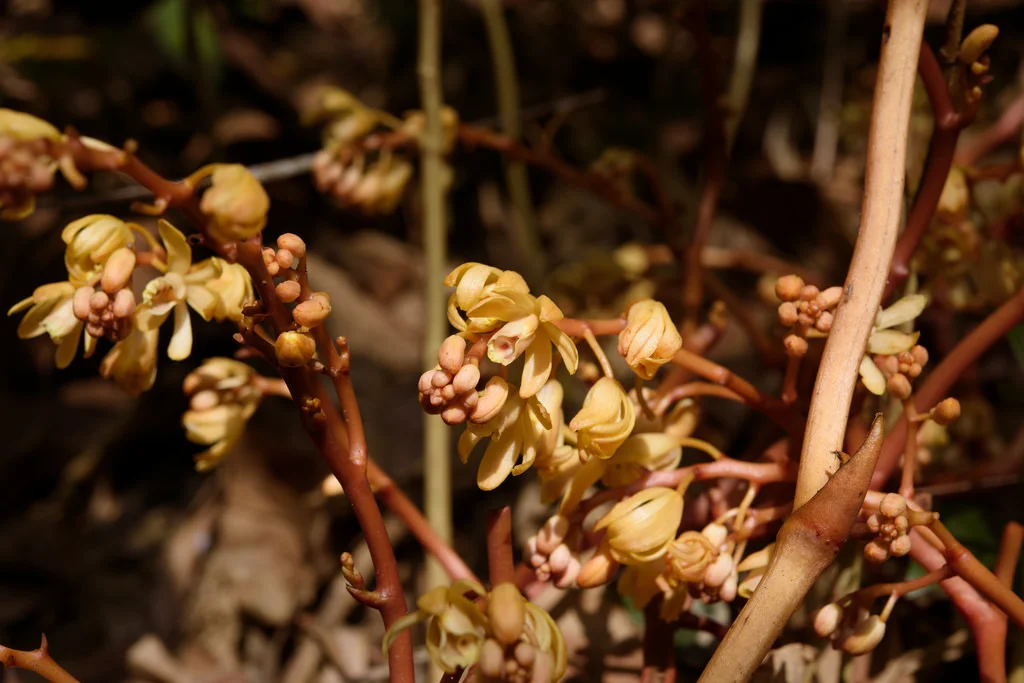Photo by mutolisp licensed under CC BY-NC-SA 2.0
Imagine a giant vine with no leaves and no chlorophyll scrambling over decaying wood and branches of a warm tropical forest. As remarkable as that may seem, that is exactly what Erythrorchis altissima is. With stems that can grow to upwards of 10 meters in length, this bizarre orchid from tropical Asia is the largest mycoheterotrophic plant known to science.
Mycoheterotrophs are plants that obtain all of their energy needs by parasitizing fungi. As you can probably imagine, this is an extremely indirect way for a plant to make a living. In most instances, this means the parasitic plants are stealing nutrients from the fungi that were obtained via a partnership with photosynthetic plants in the area. In other words, mycoheterotrophic plants are indirectly stealing from photosynthetic plants.
In the case of E. altissima, this begs the question of where does all of the carbon needed to build a surprising amount of plant come from? Is it parasitizing the mycorrhizal network associated with its photosynthetic neighbors or is it up to something else? These are exactly the sorts of questions a team from Saga University in Japan wanted to answer.
Photo by mutolisp licensed under CC BY-NC-SA 2.0
All orchids require fungal partners for germination and survival. That is one of the main reasons why orchids can be so finicky about where they will grow. Without the fungi, especially in the early years of growth, you simply don't have orchids. The first step in figuring out how this massive parasitic orchid makes its living was to identify what types of fungi it partners with. To do this, the team took root samples and isolated the fungi living within.
By looking at their DNA, the team was able to identify 37 unique fungal taxa associated with this species. Most surprising was that a majority of those fungi were not considered mycorrhizal (though at least one mycorrhizal species was identified). Instead, the vast majority of the fungi associated with with this orchid are involved in wood decay.
Stems climbing on fallen dead wood (a) or on standing living trees (b). A thick and densely branched root clump (c) and thin and elongate roots (d) [Source]
To ensure that these wood decay fungi weren't simply partnering with adult plants, the team decided to test whether or not the wood decay fungi were able to induce germination of E. altissima seeds. In vitro germination trials revealed that not only do these fungi induce seed germination in this orchid, they also fuel the early growth stages of the plant. Further tests also revealed that all of the carbon and nitrogen needs of E. altissima are met by these wood decay fungi.
These results are amazing. It shows that the largest mycoheterotrophic plant we know of lives entirely off of a generalized group of fungi responsible for the breakdown of wood. By parasitizing these fungi, the orchid has gained access to one of the largest pools of carbon (and other nutrients) without having to give anything back in return. It is no wonder then that this orchid is able to reach such epic proportions without having to do any photosynthesizing of its own. What an incredible world we live in!
Photo by mutolisp licensed under CC BY-NC-SA 2.0


![Stems climbing on fallen dead wood (a) or on standing living trees (b). A thick and densely branched root clump (c) and thin and elongate roots (d) [Source]](https://images.squarespace-cdn.com/content/v1/544591e6e4b0135285aeb5b6/1518471929195-C99KP24U24J238YMX055/myco+roots.JPG)
